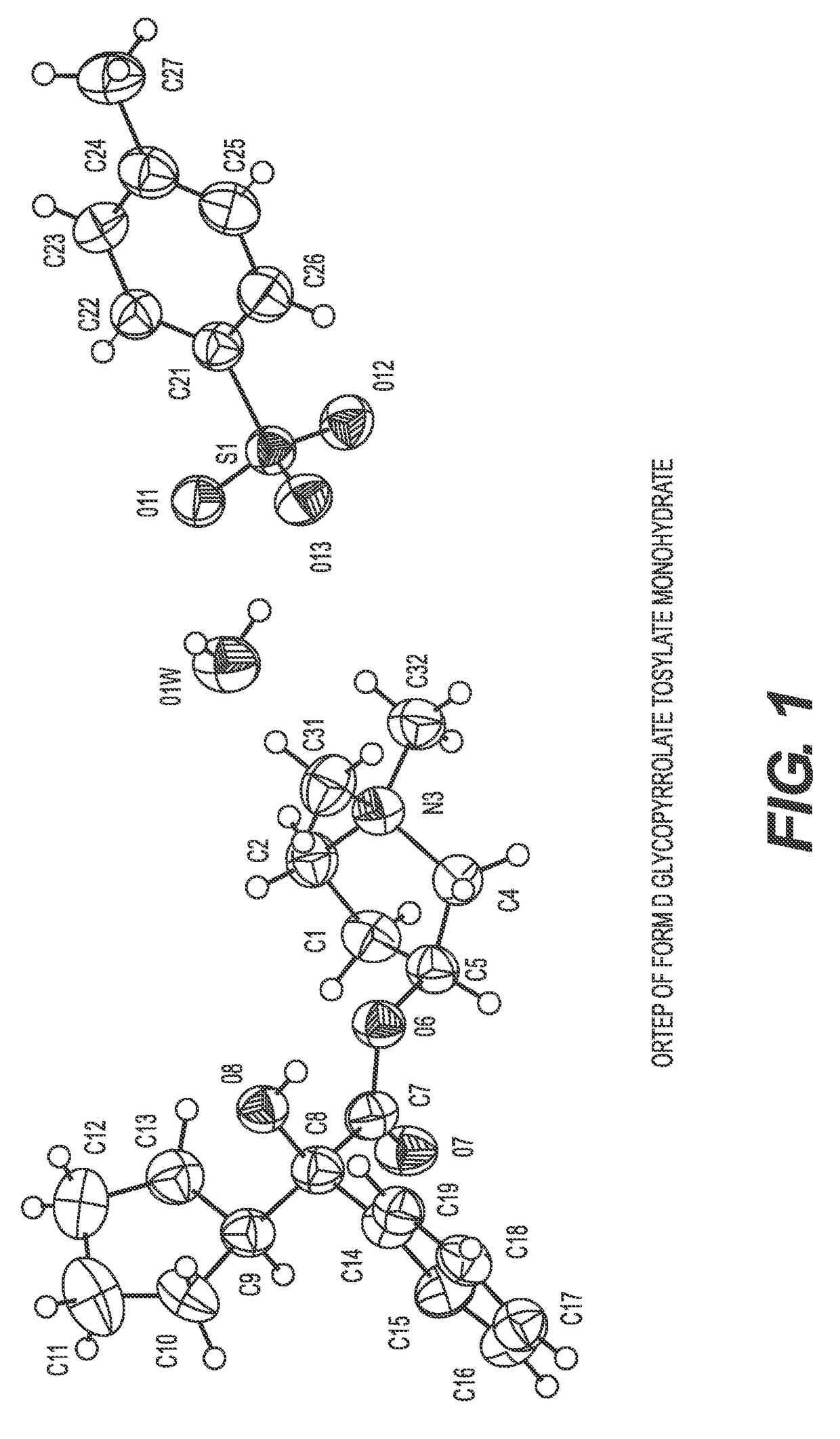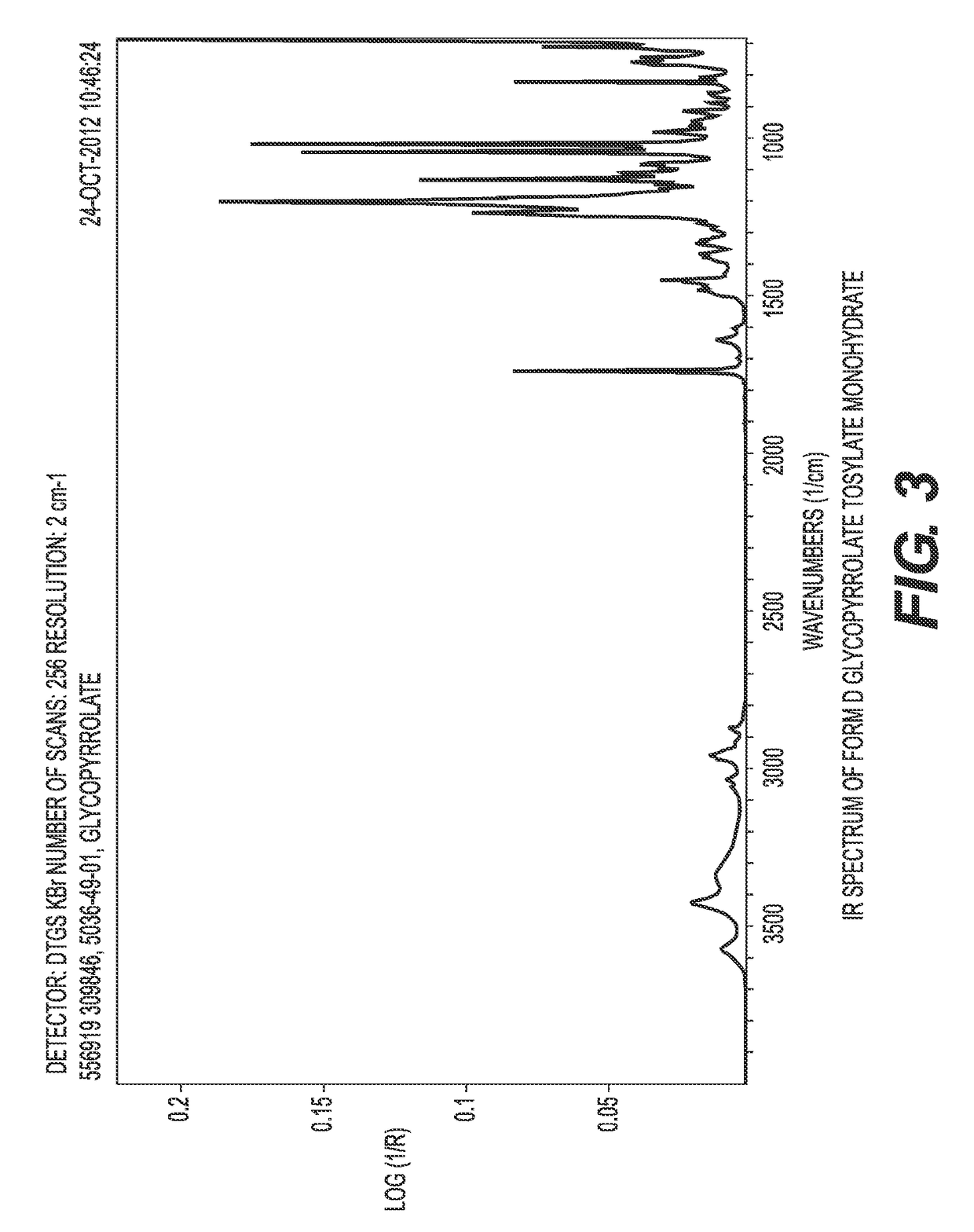Glycopyrrolate salts
a technology of glycosyl glycol and glycosyl glycol, which is applied in the field of glycosyl glycolate salts, can solve the problems of limited effectiveness, frequent skin irritation, and potential for inducing bromism
- Summary
- Abstract
- Description
- Claims
- Application Information
AI Technical Summary
Benefits of technology
Problems solved by technology
Method used
Image
Examples
example 1
Salt Screen
[0191]Fourteen salts were targeted; however, only six glycopyrrolate salts were successfully isolated and characterized: acetate, benzoate, edisylate, oxalate, hydrogen sulfate, and tosylate. These salts were formed either by (1) reaction of glycopyrrolate bromide with silver salts of salt formers, or (2) reaction of glycopyrrolate acetate with salt former acids.
example 2
Glycopyrrolate Benzoate
[0192]The glycopyrrolate benzoate salt was prepared only once using route (1) from Example 1. Glycopyrrolate benzoate was generated on reacting saturated aqueous solutions of each glycopyrrolate bromide with silver benzoate at approximately 92° C., followed by filtration and subsequent lyophilization of the mother liquor. The material was then recrystallized in acetone / MTBE (1 / 2, vol / vol) and sonicated to form white crystalline solids. An XRPD pattern associated with this material is in FIG. 12. Proton NMR showed the presence of equimolar amounts of the glycopyrrolate and benzoate species, as well as water. Thermal analysis of the sample showed a single endotherm with a peak maximum of 79° C. in the DSC thermogram concomitant with a 3.5 wt % loss between 25 and 80° C. in the TG trace. The weight loss was equivalent to approximately one mole of water indicating the formation of a monohydrate.
example 3
Di-Glycopyrrolate Edisylate
[0193]Di-glycopyrrolate Edisylate salt was formed using process (2) from Example 1. A second molar equivalent of glycopyrrolate acetate was added to the reaction mixture of glycopyrrolate acetate and a minor amount of silver acetate and one molar equivalent of 1,2-ethanedisulfonic acid in ethyl acetate / isopropanol (83 / 17, vol / vol). The mixture was stirred for approximately five minutes before the resulting grey solids were isolated and dried under vacuum at ambient temperature for one day. The dried solids were crystalline with a minor amount of silver acetate by XRPD (FIG. 14). The XRPD pattern was successfully indexed which indicated that the material was composed of a single crystalline phase. Proton NMR spectroscopy confirmed the presence of two moles of glycopyrrolate per mole of edisylate, and water. Thermal analysis of the sample showed a 3.8 wt % loss between 25 and 95° C. in the TG trace and an endotherm with a peak maximum at 103° C. in the DSC t...
PUM
| Property | Measurement | Unit |
|---|---|---|
| glass transition temperature | aaaaa | aaaaa |
| glass transition temperature | aaaaa | aaaaa |
| glass transition temperature | aaaaa | aaaaa |
Abstract
Description
Claims
Application Information
 Login to View More
Login to View More - R&D
- Intellectual Property
- Life Sciences
- Materials
- Tech Scout
- Unparalleled Data Quality
- Higher Quality Content
- 60% Fewer Hallucinations
Browse by: Latest US Patents, China's latest patents, Technical Efficacy Thesaurus, Application Domain, Technology Topic, Popular Technical Reports.
© 2025 PatSnap. All rights reserved.Legal|Privacy policy|Modern Slavery Act Transparency Statement|Sitemap|About US| Contact US: help@patsnap.com



